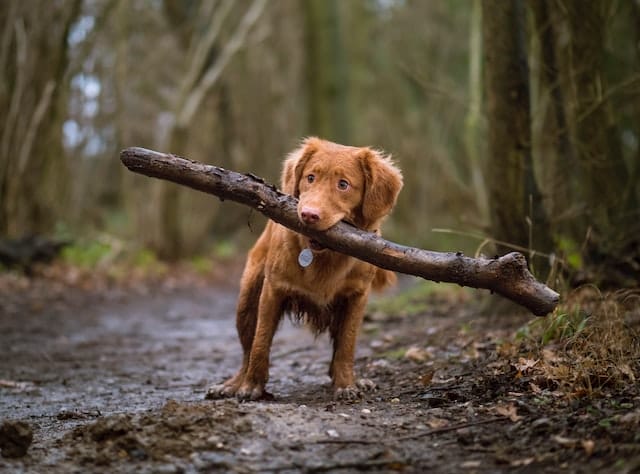
Dogs are notorious for getting lost. They often wander off when they’re exploring their surroundings, and it can be difficult to find them if they’re not wearing a collar with identification.
In this blog post, we will discuss some tips for preventing your dog from getting lost. We’ll also provide advice on what to do if your dog does get lost.
Follow these tips and you can rest assured that your furry friend will always stay safe!
What are the most common reasons dogs get lost?
There are a few common reasons that dogs end up getting lost. One is that they simply wander off when they’re exploring their surroundings. Dogs are curious creatures, and they often want to see what’s beyond the next hill or around the next corner. This can lead them into unfamiliar territory, where it may be difficult to find their way back home.
Dogs can also get lost for a variety of reasons, including running away or escaping from their yard or house. Dogs may dig under a fence, jump over one, or even open a door in order to exit. Once they’ve escaped, dogs might not know how to return. If the dog is scared or nervous, this may be especially true.
Dogs may also get lost if they’re left in a vehicle on their own. The dog may not be able to discover the automobile again if it is parked in an unfamiliar location. The dog might also become stranded if the RV is driving and be unable to keep up, thus becoming lost along the route.
What is the best way to search for your pet?
The best way to search for your pet is to start as soon as possible. The sooner you start looking, the better your chances are of finding them. You should also enlist the help of friends, family, and even strangers in your search. The more people you have looking for your dog, the greater the chance that someone will find them.
For instance, if the dog is lost in a rural area, you might want to organize a search party. Everyone should fan out and cover as much ground as possible. It’s also important to call your dog’s name frequently and whistle if they know how to come when called.
Put up posters with the dog’s photograph and your contact information in an urban environment. You should also inquire about whether your pet has been found and taken to a local animal shelter or veterinarian if they’ve gone missing.
Get a collar with identification
The first step in preventing your dog from getting lost is to make sure that he or she is wearing a collar with identification. This way, if your dog does wander off, anyone who finds him or her will be able to quickly and easily get in touch with you. These collars can be purchased at most pet stores, and they usually have your contact information printed on them. For instance, there are companies that offer GPS dog collars. These work like the Halo GPS collar, by tracking the location of your dog at all times. If he or she happens to wander off, you’ll be able to track their exact location and go get them. While GPS collars may cost a bit more than traditional ones, they could end up saving you a lot of time and worry in the long run
Make sure your dog is microchipped

When you want to be sure that you can always find your dog, another great option is to have him or her microchipped. This is a small chip that’s inserted under the skin, usually between the shoulder blades. The chip contains your contact information, as well as the dog’s identification number. If your dog is ever lost, any animal shelter or veterinarian will be able to scan the chip and get in touch with you.
Microchipping is a quick and easy procedure that can be done at most animal shelters, veterinarians, or even some pet stores. It’s relatively painless for your dog, and it could end up being a lifesaver.
Take precautions when traveling
If you’re planning on taking a trip with your dog, it’s important to take some precautions to prevent them from getting lost. First, make sure that your dog is wearing a collar with identification. You should also microchip your dog before traveling, just in case they wander off while you’re in a new place.
Don’t forget your dog when packing for the trip! Bring their food, water, and medications. just in case you lose them while on vacation, bring along a recent photo to make lost posters. If you’re going to be renting a room in a hotel or other property, inquire about their pet policy ahead of time. Some hotels have strict regulations on keeping dogs in the rooms, while others may charge extra fees.
When you get to your destination, take some time to acclimate your dog to the new environment. Show them where their food and water bowls are as well as where they’re allowed to go pee. After your dog is comfortable, you may begin exploring the area together. Just make sure they’re on a leash so they don’t stray off.
Keep your dog on a leash

When you’re out and about with your dog, it’s important to keep him or her on a leash. This will prevent them from running off and getting lost.
If you’re at a park or beach where there are off-leash dog areas, make sure to keep an eye on your furry friend at all times. Otherwise, they may wander off and get lost in the crowds.
Depending on the breed, the best type of leash may vary. For example, small dogs may do better with a harness and leash combo, while larger dogs may need a standard leash.
You can ask your veterinarian or a pet store employee for advice on which type of leash is best for your dog.
Train your dog to come when called
One of the best ways to prevent your dog from getting lost is to train them to come when called. This way, if they ever do wander off, you can simply call their name and they’ll come running back to you. You can start training your dog to come when called by using treats as a reward.
For example, every time you call your dog’s name and they come to you, give them a treat. Soon, they’ll learn that coming when called results in a tasty reward.
You can also use this command in conjunction with the “stay” command to prevent your dog from running off in the first place.
Be careful during holidays and fireworks
Holidays like Independence Day and New Year’s Eve can be especially dangerous for dogs. Fireworks are often set off during these times, which can startle and scare your dog.
If they get scared enough, they may run off and get lost. To prevent this from happening, keep your dog indoors during fireworks displays. You may also want to put on some calming music to help them relax.
Making sure your dog has an ID tag on is one of the most important things you can do to keep them safe during holidays.
That way, if they are lost, anyone who finds them will be able to contact you promptly and simply.
Have regular ID checks
One way to ensure that your dog’s identification is up-to-date is to have regular ID checks with your local animal shelter or vet’s office.
This way, you can be sure that your contact information is correct and that the ID tag is still readable.
Namely, a usual dog tag can get worn down over time and become unreadable.
Alternatively, your contact information may have changed since you got your dog, so it’s important to keep it updated.
By having regular ID checks, you can be sure that your dog will be returned to you if they ever do get lost.
Be cautious when bringing a new pet into the home
If you’re considering adding a new pet to your family, it’s important to be cautious. Dogs that are not properly introduced to other animals can become fearful and run off.
When bringing a new pet home, make sure to introduce them to your dog slowly and in a calm environment.
It’s also important to keep an eye on your dog when they’re around other animals. If you notice that they’re acting scared or aggressive, it’s best to remove them from the situation.
Namely, there are instances when two dogs may not get along and one may chase after the other. If this happens, the dog that’s being chased may run off and become lost.
So, there you have it! When it comes to preventing your dog from getting lost, these tips should be helpful.
Just remember to keep an eye on your furry friend at all times and make sure they have a current ID tag with your contact information.
With a little bit of caution, you can help ensure that your dog always stays safe and sound.


GIPHY App Key not set. Please check settings